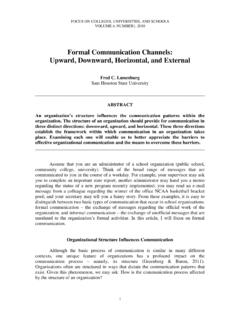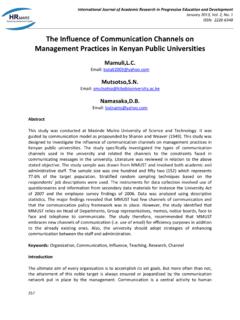Transcription of ORGANIZATIONAL COMMUNICATION AS AN IMPORTANT …
1 Interdisciplinary Management Research V ORGANIZATIONAL COMMUNICATION AS AN IMPORTANT FACTOR OF ORGANIZATIONAL BEHAVIOUR eljko Turkalj1, Ivana Fosi 21 Faculty of Economics in Osijek, Croatia, 2 Faculty of Economics in Osijek, Croatia, _____AbstractOrganization sets itself specific objectives in order to meet the better business success, and to gain comparative advantage over the competition. For these objectives to be achieved, of crucial importance is ORGANIZATIONAL COMMUNICATION per se which implies COMMUNICATION among employees, as well as COMMUNICATION between different hierarchic levels in the same organization. COMMUNICATION as an element of ORGANIZATIONAL behaviour is seen through the group level as the independent variable. Throughout this paper we shall explain the importance of COMMUNICATION for organization, the communicational process and channels for information flow through the network of small formal groups and the network of informal groups.
2 Hereby we also want to emphasize the greater need for appreciation of COMMUNICATION as the IMPORTANT factor of ORGANIZATIONAL behaviour due to the growing changes in organizations which face the leadership with new challenges and opportunities for testing the different ORGANIZATIONAL behaviour concept modes. We will also demonstrate the extent of satisfaction with COMMUNICATION within the observed economic operators in Osijek-Baranja County, and evaluate the impact of COMMUNICATION on the employee level on business performance of the same. JEL classification: D23, M14 Keywords: COMMUNICATION , organization, ORGANIZATIONAL behaviour, COMMUNICATION satisfaction_____1. THE IMPORTANCE OF COMMUNICATION FOR ORGANIZATION ORGANIZATIONAL behaviour becomes more and more IMPORTANT for the growing role of the man in social processes, as well as in their management.
3 According to Robbins the discipline of ORGANIZATIONAL behaviour (OB) is a systematic study of actions and attitudes that people exhibit within the organisation. (Robbins; 1992, 1.) Thereby the elements of organisational behaviour become more and more IMPORTANT since the development of quality organisational behaviour can increase the competitive ability of the company and market value of the Management Research V The subject matter of the systematic study of the discipline of organisational behaviour is actions of which the most IMPORTANT ones are three determinants of employee productivity. They are reflected through productivity, absenteeism and workforce fluctuation, and great attention is paid to satisfaction at workplace since it reflects the attitudes of the employees which are also the subject of the systematic study of the discipline of organisational of the elements of ORGANIZATIONAL behaviour enables a better understanding, predicting and control of ORGANIZATIONAL as an element of ORGANIZATIONAL behaviour is observed through the level of group behaviour.
4 COMMUNICATION is one of the central components of every organization; therefore, it is clear why is the better understanding of COMMUNICATION efficacy the key to the overall ORGANIZATIONAL success. ( ) Business COMMUNICATION is usually divided to the one within the organization, and the one outside the organization. COMMUNICATION is the process of conveying the message from one person to the other (Weick and Browing, 1986), however it is very IMPORTANT that the recipient of the information understands the content and the meaning of the message. (Rouse 2005, 40.) Weihrich and Koontz state that the function of COMMUNICATION in the organisation is to connect the employees of that organisation in order to reach mutual , the importance of COMMUNICATION in the organisation is IMPORTANT because of: the company s goal setting and their carrying out, the development of plans towards their realisation, human and other resources management in the most successful and appropriate way, the choice, the progress and the performance evaluation of the organisation members, the management, guiding, motivating and creating a climate in which people want to contribute, the control over realisation.
5 (Weihrich 1994, 538.) COMMUNICATION in the organisation represents a complex system of the flow of information, orders, wishes and references made out of two partially complementary systems: formal COMMUNICATION network and informal COMMUNICATION network. (Fox; 2001, 41.) 34 Interdisciplinary Management Research V Formal COMMUNICATION is a systematic and formal process of information transmission in spoken and written form planned in advance, and adjusted with the needs of the organisation. (Fox; 2001, 42.) While informal COMMUNICATION does not follow the line determined in advance, but there is an undisturbed COMMUNICATION between particular groups within the process of COMMUNICATION involves several elements: the sender, the message, the medium, and the recipient.
6 COMMUNICATION flows from the sender which is the source of the COMMUNICATION (be it an individual or a group). He sends off the message to the recipient using a particular medium. When talking about the COMMUNICATION within the organisation, characteristic for the medium are different immediate conversations, memos, printouts and schemes depending on the content and the aim of the message which the sender wants to convey to the recipient. The recipient then attempts to understand which message the sender wants to convey, although the COMMUNICATION process may sometimes be interrupted by a noise in the COMMUNICATION channel, which can impede the COMMUNICATION . The problem which often appears within the organisation is getting information overload which leads to a burden, so therefore it is IMPORTANT to take account of selecting only the relevant flow in the organisation can develop into many different directions: upward COMMUNICATION , downward COMMUNICATION and sideward COMMUNICATION the one which goes up the official hierarchy, from the lower to the higher level in the organisation.
7 Information go from the subordinates to the superiors. It is mostly used for sending information associated with the proposals system, employees opinion, work insight, attitudes and problems of the employees. It is IMPORTANT to secure the freedom of communicating (undisturbed information flow) since the main drawback of the upward COMMUNICATION is message COMMUNICATION flows from the higher to the lower levels in the organisation. It is characteristic for giving orders, broadening of ideas and communicational knowledge. It takes up a lot of time, but its most common problem is the loss or denying of information on the path through the chain of command; very often there is misunderstanding of the directions, therefore a backward connection has to be established in order to confirm the transmission of correct and full and Koontz term the horizontal and diagonal flow of information a sideward COMMUNICATION , because of their generic joint features.
8 S. P. Robbins 35 Interdisciplinary Management Research V terms them a lateral COMMUNICATION . Horizontal COMMUNICATION appears among people of the same status within a department or among different working units, whereas the diagonal COMMUNICATION appears among people of the different status who are not formally connected in the organisational COMMUNICATION system. (Fox; 2001, 41.) COMMUNICATION can develop into several different forms: oral, written and non-verbal COMMUNICATION the spoken word is the main code of the COMMUNICATION . Formal discussions and informal rumours are some of the forms of oral COMMUNICATION . Usual channels of oral COMMUNICATION are phone, video, and face-to-face conversations. There are some advantages of oral COMMUNICATION over other forms of COMMUNICATION , namely the speed of conveying the information and feedback.
9 The disadvantage, however, is the possibility of distorting the original message. In the business world oral COMMUNICATION plays a great COMMUNICATION compared to the oral COMMUNICATION it is tangible whereby it is much easier to verify the data. One of its disadvantaged is that it takes up more time compared to the oral COMMUNICATION and there is not a direct feedback. The written form of the COMMUNICATION is attached to some sort of technology which enables us to convey the information (PC, paper, ).Nonverbal COMMUNICATION facial expression, gesturing, tone of the voice, look and appearance are some of the elements of non-verbal COMMUNICATION . Non-verbal COMMUNICATION implies all intentional and accidental meanings which have no form of a written or spoken word.
10 (Rouse &Rouse, 2005, 47.) Non-verbal form of the COMMUNICATION is often neglected compared to the other forms of COMMUNICATION . IMPORTANT advantages of non-verbal COMMUNICATION are that it supports other forms of COMMUNICATION ; whereas the disadvantage is that the recipient may misconceive the message and consequently misinterpret COMMUNICATIONAL NETWORKS IN THE ORGANISATION Besides already mentioned ways of COMMUNICATION , there are channels through which information flow, which is very IMPORTANT for analysing the COMMUNICATION as the element of organisational behaviour, and those are formal small group network and informal group Management Research V Formal small group networksPicture 1. Three forms of network in small formal groupsChain Circle Wheel Source: according to Robbins, S.





